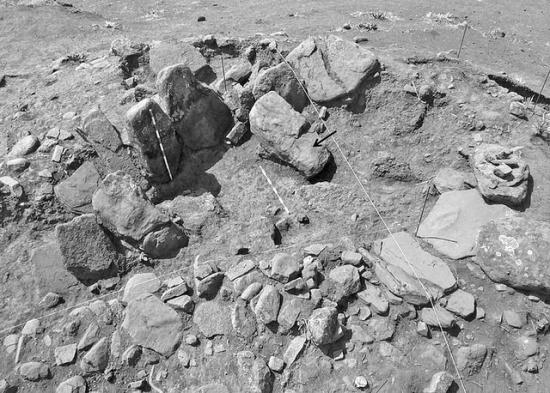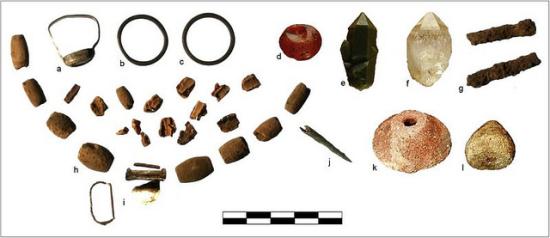Source - http://popular-archaeology.com/issue/june-2013/article/iron-age-hoard-in-a-megalithic-funerary-complex-in-spain

Orthostat under which the hoard was found indicated by the arrow. Image and text from Mercedes Murillo-Barroso, et al., New objects in old structures. The Iron Age hoard of the Palacio III megalithic funerary complex (Almaden de la Plata, Seville, Spain), Journal of Archaeological Science, Vol. 57, May 2015, pp. 322 -334
Discovered among the remains of a megalithic funerary structure on a hill in the Andalusia region of southern Spain, an exotic assemblage of Iron Age artifacts dated to between 1044 and 538 BCE has long raised questions for archaeologists regarding its origin and meaning. Described as a ‘hoard’ by the archaeologists because of the unusual, exotic characteristics of the objects and their spatial association suggesting a single, one-time undisturbed deposit, it has been the focus of intense scientific study by Mercedes Murillo-Barroso of the University College London and colleagues of other participating institutions in Spain and the U.K.
Now, Barosso and colleagues have released the results of their study in a paper published in the Journal of Archaeological Science.
“This hoard, found under the fallen orthostat of a megalithic structure built at least 2,000 years earlier, throws new light on long-distance exchange networks and the effect they could have had on the cultural identities and social relations of local Iberian Early Iron Age communities,” stated Barosso and colleagues in the report.*
The researchers conclude this because at least some of the objects of the hoard, which consists of three silver rings, one of them a signet ring, three exotic quartz objects, a necklace of amber beads, a pendant, fine wires of silver, a bronze needle, two spindle whorls and two small iron bars, were made of materials that were sourced from locations as distant and diverse as the Baltic, western Mediterranean, and the Middle East.

The hoard included a signet ring (a), two silver rings (b and c), one carnelian quartz (d), one prase quartz (e), one rock monocrystal quartz (f), two small iron bars (g), amber beads (h), one silver pendant (i), one bronze needle (j) and two spindle whorls (k and l). Image and text from: Mercedes Murillo-Barroso, et al., New objects in old structures. The Iron Age hoard of the Palacio III megalithic funerary complex (Almaden de la Plata, Seville, Spain), Journal of Archaeological Science, Vol. 57, May 2015, pp. 322 -334
The megalithic structure is the oldest of three structures found at what has been called the ‘Palacio III’ funerary complex. Each structure was built at a different time during the course of several millennia. The other two are described as a Chalcolithic period tholos featuring a corridor that connects to a circular chamber; and an Iron Age grave with cremated remains sealed with large horizontal stone slabs and covered with a tumulus of stones.
The researchers analyzed the hoard objects found beneath the oldest, megalithic structure, which was dated to the Late Neolithic or Copper Age, using a variety of cutting-edge techniques and technologies at several laboratories.
“Various strands of evidence suggest that the Palacio III artefacts were made and used in the Early Iron Age (9th to 6th centuries BCE),” stated Barasso, et al. “From a chronological point of view, the deposition of the hoard in what appears to be the oldest structure of the Palacio III funerary complex is clear evidence of the reuse of this structure many centuries after its original construction.”*
Given the placement and characteristics of the hoard, the researchers theorize that the assemblage was either deposited as an ‘emergency hoard’ by someone or a group attempting to secure or hide it temporarily under adverse circumstances for safekeeping until it could be later retrieved; or that it was deposited as a votive offering during ritualistic activity.
Regardless of the reasons or circumstances of placement, however, the researchers see the study of the objects as an opportunity to shed some light on the complexity of culture and society during the Iron Age at a facility that apparently had its roots going back 2,000 years earlier.
“Although relatively small in size,” concluded Barasso, et al., “this assemblage straddles several millennia, and references communities and resources of northern Europe, the western Mediterranean and the Near East. Its complexity is representative of the fluctuations in trade, power and identity across the Mediterranean in the 1st millennium BCE, and illustrative of the power of archaeological science to help us disentangle them.”*
The detailed report can be read as an open access paper published in the Journal of Archaeological Science.
Mercedes Murillo-Barroso, et al., New objects in old structures. The Iron Age hoard of the Palacio III megalithic funerary complex (Almaden de la Plata, Seville, Spain), Journal of Archaeological Science, Vol. 57, May 2015, pp. 322 -334